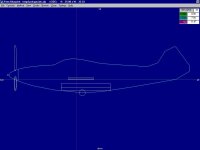This thread will describe the construction of a Bell P-39 Airacobra for Combat Flight Simulator.
Over the last several months, I have been heavily involved in discussions about the design issues, performance, and handling issues that resulted from the location of the engine behind the pilot instead of its usual location at the nose to drive a tractor propeller. Some pilots loved the 'Cobra. Some hated it and thought it was the worst production fighter built by the United States.
I have always thought the Airacobra was a fascinating design and this will be my attempt to build one.
As with most projects, one has to decide upon a version to build. The Airacobra was a fighter, so the version to build should be one that saw service as a principal front line fighter.
My own choice to build would be one that most represented the type's characteristics when it served as a fighter with US forces early in the war.
To me this means it should be the "Flying Cannon".
It should carry a 37 mm M4 Cannon instead of the very common (for export) 20 mm Hispano.
It should carry the 4 x .30 Caliber (or .303) MG in the wings.
As I start this project, I have not yet determined the exact model of the Airacobra I intend to build.
In the next post, I will explain why the choice is not so easy.
- Ivan.
Over the last several months, I have been heavily involved in discussions about the design issues, performance, and handling issues that resulted from the location of the engine behind the pilot instead of its usual location at the nose to drive a tractor propeller. Some pilots loved the 'Cobra. Some hated it and thought it was the worst production fighter built by the United States.
I have always thought the Airacobra was a fascinating design and this will be my attempt to build one.
As with most projects, one has to decide upon a version to build. The Airacobra was a fighter, so the version to build should be one that saw service as a principal front line fighter.
My own choice to build would be one that most represented the type's characteristics when it served as a fighter with US forces early in the war.
To me this means it should be the "Flying Cannon".
It should carry a 37 mm M4 Cannon instead of the very common (for export) 20 mm Hispano.
It should carry the 4 x .30 Caliber (or .303) MG in the wings.
As I start this project, I have not yet determined the exact model of the Airacobra I intend to build.
In the next post, I will explain why the choice is not so easy.
- Ivan.




















